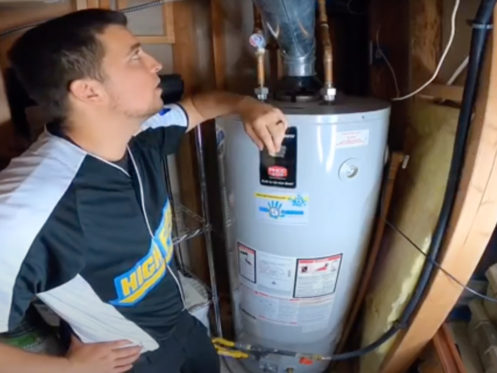Almost everyone may have their private assumption on the subject of Tips on Maintaining a Water Heater.

Warm water is necessary for day-to-day comfort, whether it's for a refreshing shower or washing meals. To guarantee your warm water system runs successfully and lasts much longer, normal upkeep is crucial. This write-up gives practical tips and insights on how to preserve your home's warm water system to stay clear of disturbances and expensive repair services.
Intro
Keeping your home's warm water system could appear overwhelming, however with a couple of straightforward actions, you can guarantee it runs efficiently for many years to find. This guide covers everything from understanding your warm water system to DIY maintenance tips and knowing when to contact specialist aid.
Relevance of Maintaining Your Hot Water System
Regular upkeep not just extends the lifespan of your hot water system but also ensures it runs successfully. Disregarding upkeep can bring about decreased efficiency, greater power costs, and even premature failure of the system.
Signs Your Hot Water System Requirements Upkeep
Recognizing when your warm water system needs attention can avoid major issues. Keep an eye out for signs such as irregular water temperature level, unusual sounds from the heating system, or rusty water.
Flushing the Hot Water Heater
Flushing your water heater gets rid of sediment build-up, improving performance and prolonging its life.
Monitoring and Changing Anode Rods
Anode rods stop deterioration inside the storage tank. Evaluating and replacing them when worn is crucial.
Complicated Problems Calling For Professional Help
Instances include significant leaks, electric issues, or if your hot water heater is consistently underperforming.
Regular Professional Upkeep Benefits
Specialist maintenance can consist of comprehensive examinations, tune-ups, and making certain compliance with safety criteria.
Inspecting and Readjusting Temperature Setups
Readjusting the temperature setups ensures ideal efficiency and safety and security.
DIY Tips for Upkeep
You can perform a number of upkeep tasks yourself to maintain your hot water system in leading problem.
Checking for Leakages
Regularly examine pipelines and connections for leaks, as these can result in water damage and greater costs.
Understanding Your Hot Water System
Prior to diving into maintenance tasks, it's valuable to recognize the basic elements of your warm water system. Typically, this includes the hot water heater itself, pipes, anode poles, and temperature controls.
Month-to-month Maintenance Tasks
Regular regular monthly checks can aid capture minor concerns before they escalate.
Checking Stress Alleviation Valves
Examining the stress relief valve ensures it works properly and avoids extreme stress build-up.
Protecting Pipelines
Shielding hot water pipes lowers warmth loss and can conserve power.
When to Call a Specialist
While DIY maintenance is advantageous, some problems need expert experience.
Final thought
Routine upkeep of your home's warm water system is crucial for efficiency, longevity, and cost savings. By following these pointers and recognizing when to look for specialist aid, you can make sure a trustworthy supply of warm water without unanticipated disturbances.
How to Maintain an Instant Hot Water Heater
Before tinkering with your hot water heater, make sure that it’s not powered on. You also have to turn off the main circuit breaker and shut off the main gas line to prevent accidents. Also turn off the water valves connected to your unit to prevent water from flowing into and out of the appliance. 2. When you’re done, you have to detach the purge valves’ caps. These look like the letter “T” and are situated on either side of the water valves. Doing so will release any pressure that has accumulated inside the valves while at the same time avoid hot water from shooting out and burning your skin. 3. When the purge valves’ caps are removed, you have to connect your hosing lines to the valves. Your unit should have come with three hoses but if it didn’t, you can purchase these things from any hardware or home repair shops. You can also get them from retail stores that sell water heating systems. Read the user’s manual and follow it to complete this task properly. When the hosing lines are connected, open the purge port’s valves. 4. You should never use harsh chemical cleaners or solutions when cleaning your unit. Make use of white vinegar instead. It should be undiluted and you’ll probably use about 2 gallons. 5. Now flush your water heater. This task should probably take about 40 minutes. We can’t give you specific directions for this because the procedure is carried out depending on the type, model and brand of your heater. With that being said, refer to the user’s manual. 6. When you’re done draining the unit, you have to turn off the purge port valves again. Remove the hosing lines that you earlier installed on each of the water valves. Put the valve caps (purge port) back in their respective places and be very careful so as not to damage the rubber discs that are found inside these caps. 7. Now that everything’s back in place, check your user’s manual again to find out how to reactivate your water heating system. 8. Once it is working, turn one of your hot water faucets on just to let air pass through the heater’s water supply pipes. Leave the tap on until water flows smoothly out of it. https://www.orrplumbing.com/blog/2014/september/how-to-maintain-an-instant-hot-water-heater/
Do you enjoy reading about Water Heater Maintenance Tips You Can't Afford to Forget? Create a remark further down. We will be happy to see your thinking about this blog posting. In hopes that you come back again soon. Are you aware of anybody else who is excited by the subject? Please feel free to share it. Thanks a lot for being here. Don't forget to come visit our blog back soon.
Browse Our Site